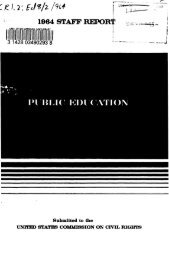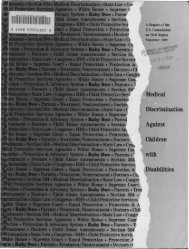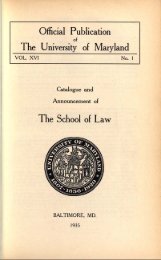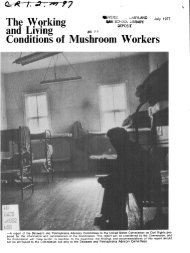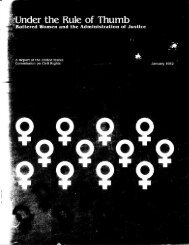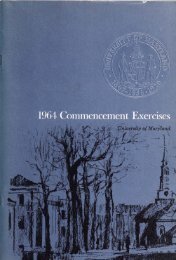1961 US Commission on Civil Rights Report Book 2 - University of ...
1961 US Commission on Civil Rights Report Book 2 - University of ...
1961 US Commission on Civil Rights Report Book 2 - University of ...
You also want an ePaper? Increase the reach of your titles
YUMPU automatically turns print PDFs into web optimized ePapers that Google loves.
students wishing to do so could register at the Negro high school without<br />
regard to their residence. White students living in the z<strong>on</strong>e <strong>of</strong><br />
the Negro school were given a similar privilege regarding the white<br />
high school. Fifty-nine Negro students chose not to exercise this<br />
opti<strong>on</strong> and registered at the white school in their residential z<strong>on</strong>e. 81<br />
Their registrati<strong>on</strong> forms were marked with a special identifying symbol.<br />
In making original assignments (registrati<strong>on</strong> apparently being c<strong>on</strong>sidered<br />
an applicati<strong>on</strong> therefor) <strong>of</strong> 2,600 students "en masse," the board<br />
assigned 3 Negroes to each <strong>of</strong> 2 formerly white schools where they had<br />
registered, and all <strong>of</strong> the other 53 Negroes to the Negro school, despite<br />
their areas <strong>of</strong> residence or their places <strong>of</strong> registrati<strong>on</strong>. All white students<br />
were assigned where they registered. The U.S. Court <strong>of</strong> Appeals for<br />
the Eighth Circuit held these initial assignment procedures invalid: ° 2<br />
... It is established without any serious dispute that the board's<br />
assignment criteria under the pupil placement laws was [sic] not<br />
applied to any white student in making these initial assignments;<br />
that no white student was refused assignment to the school <strong>of</strong> his<br />
residence area or registrati<strong>on</strong>; and although c<strong>on</strong>troverted, the<br />
evidence c<strong>on</strong>vincingly establishes that in making the initial asassignments<br />
<strong>of</strong> plaintiffs and other Negro students, the board's<br />
acti<strong>on</strong> was motivated and governed by racial c<strong>on</strong>siderati<strong>on</strong>s.<br />
In the c<strong>on</strong>solidated cases <strong>of</strong> Wheeler v. Durham City Board <strong>of</strong><br />
Educati<strong>on</strong> and Spaulding v. Durham City Board <strong>of</strong> Educati<strong>on</strong>,** the<br />
court specifically c<strong>on</strong>demned the school board's practice <strong>of</strong> assigning<br />
elementary students <strong>on</strong> the basis <strong>of</strong> two sets <strong>of</strong> city maps, <strong>on</strong>e z<strong>on</strong>ed<br />
exclusively for white students and the other for Negroes. It also criticized<br />
plaintiffs for giving little informati<strong>on</strong> (other than the desire to<br />
attend an integrated school) as to why reassignment was requested.<br />
The court said plaintiffs were in fact seeking a totally integrated school<br />
system rather than reassignment to any particular school. Citing<br />
Briggs v. Elliott * 4 and Thomps<strong>on</strong> v. County School Board <strong>of</strong> Arlingt<strong>on</strong><br />
County, 6 ' it repeated, "the C<strong>on</strong>stituti<strong>on</strong> <strong>of</strong> the United States does not<br />
require integrati<strong>on</strong>, but merely forbids discriminati<strong>on</strong>." M<br />
The problem here as in other North Carolina cases is that plaintiffs<br />
were attempting to challenge initial assignments by race as a c<strong>on</strong>tinuati<strong>on</strong><br />
<strong>of</strong> the segregated system, but the Fourth Circuit rule required them<br />
to apply for reassignment and protest the denial <strong>of</strong> reassignment.<br />
Nevertheless, the court held specific practices <strong>of</strong> the board "discriminatory<br />
and thus forbidden by the i4th amendment." 67 In additi<strong>on</strong> to<br />
assignment by a dual system <strong>of</strong> attendance areas and the lateness <strong>of</strong><br />
notice, it c<strong>on</strong>demned "the failure <strong>of</strong> the board to adopt any criteria or<br />
standards for c<strong>on</strong>sidering applicati<strong>on</strong>s for reassignment, and the failure<br />
<strong>of</strong> the board to apply such criteria or standards equally to whites and<br />
96






